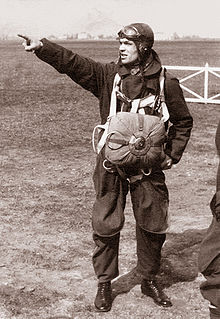By Al (Alvydas) Karaša
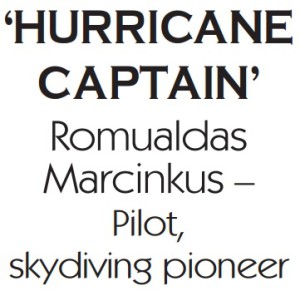
“Never was so much owed by so many to so few.” These words of praise by Winston Churchill for the airmen who defended England during the Battle of Britain are well known. But did you know that among those few was a pilot from the Lithuanian Air Force?
AS SOON AS I STARTED RESEARCH ABOUT this remarkable man, I knew his story was one which should be told and should be heard. It is so full of adventure, extraordinary bravado, and unlikely outcome, that it seems unbelievable for it all to be packed into such a short period of time. He presents a Hollywoodesque figure we associate more with fantasy than reality.
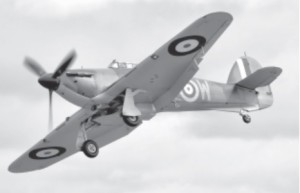
Perhaps mentioning his connection to France is as good a point to start with as any. When Napoleon’s army of invasion was driven back in defeat across Lithuania, a number of Frenchmen stayed behind. A man named Courvoisier was one of those men. He married a Lithuanian and established his home in the country. Very little else is know about him. But this ancestor of Romualdas Marcinkus is the nebulous French connection of some importance later in his life.
Romualdas Marcinkus was the eldest of five children. He was born in Jurbarkas on July 22, 1907. His ather served as constable during the Tsar’s rule of Lithuania. He grew up multilingual due to family background and foreign schooling in his early education.
After Lithuania gained her independence in 1918, the Marcinkus family moved to Kaunas in pursuit of further education for the children. Romualdas ( Romas to his friends) attended the Higher German School there before enrolling in the Kaunas Military School with the intention to join the rapidly growing Lithuanian Army. He immediately excelled in sports and took on soccer as his chosen game. By 1927, he was playing in international matches and showed great promise as a talented soccer player. When he graduated from the Kaunas Military School the following year, he was already a soccer star.—His military career changed course in the early 1930s. Vytautas the Great Military Institute had an aviation department. Following a long time fascination with flying, Marcinkus attended and earned his pilot credentials. Soccer–his other passion–however, did not suffer. He was national champion three times, and his team won the Baltic Championship twice. He was a celebrity and later became the national team’s head coach.
In 1933, he married another prominent sports personality– Aleksandra Lingytė. She was a champion basketball player with the Lithuanian national team that represented the country in international competition. Their marriage was celebrated across the country. Both were recognized stars of the sports world. They personified the highest level of Lithuania’s sporting aspirations.
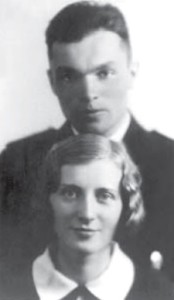
The next few years brought new challenges. Inspired by Air Force captain Klemensas Martinkus–a noted test jumper–Marcinkus took an active interest in parachuting. His expertise developed rapidly. “Jumping out of a perfectly good airplane” as they say, seemed second nature to him. He began experimenting and improved the known technique. It wasn’t long before he became a paratrooper instructor. As master parachut- ist, he participated in air shows where he demonstrated the so-called delayed jumps.
This style of parachuting was virtually unknown at the time. We know it today as skydiving. He was one of the earliest proponents of this sport and one of skydiving’s pioneers. Keep in mind that parachuting of any kind was then risky business, let alone skydiving. The parachute was to be used only as a last resort, when all hope of survival was otherwise lost. Using one for sport was a completely new and unorthodox concept.
After promotion to lieutenant, Marcinkus was transferred to Air Reconnaissance. Then, perhaps due to his celebrity as well as his flying prowess, he was invited to take part in an aviation event of great importance to the fledgling Lithuanian Air Force. The invitation came from Antanas Gustaitis, the Air Force Commander himself. This undertaking was reserved for the best pilots in the country. It included the top names in Lithuanian military aviation: Juozas Namikas, Jonas Liorentas, Jurgis Savickis, Kazys Rimkevičius, Jonas Mikūnas, Romualdas Marcinkus, and Antanas Gustaitis.
Three ANBO IV aircraft, designed by Gustaitis, took to the air on June 25th, 1934. Participation in this trans-European flight brought many accolades. The flight took twenty-five days to complete and included visits to the capital cities of twelve European countries. The pilots were received by royalty and heads of state everywhere they landed. It was a demonstration of Lithuania’s new air force on a grand scale.
Soon after his return, for his many contributions to aviation, Marcinkus was decorated with Plieno Sparnai (Steel Wings)–the highest award in Lithuanian Military Aviation–and elevated to the rank of Captain. For his service to his country, he also received the Order of Grand Duke Gediminas Knight’s Cross.
Due to a serious knee injury during a soccer match in Riga, his sporting pursuits came to an end in 1938. After hospitalization in Kaunas and extensive treatment in Czechoslovakia, Germany, and England, and a long recovery, he was named head of the Lithuanian Aviation Physical Education Department, where he served for a relatively short time.
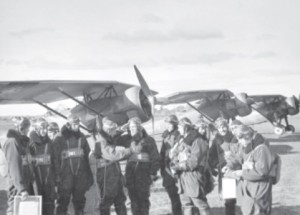
His release from active duty in 1939 is under some controversy. Having devoted seven years to building a career in military aviation, he suddenly requested to be relieved of duty. It was viewed as an unreasonable action on his part.
Was it due to a reprimand and imposed house arrest for his alleged unsatisfactory conduct in regard to an interned German officer under his care? But it is doubtful that he would have taken such drastic action on account of a single incident. Or, was there a plan to join the French Air Force when Russian invasion came to his home country? We will never know, since he left Lithuania under mysterious circumstances that have never been explained.
Although Lithuania remained neutral in the conflict, Russia’s unprovoked attack on Finland turned some Lithuanian military heads in that direction. It is not known under what circumstances Marcinkus left Lithuania in what is assumed to have been his intention to join the Finnish armed forces against Russia. His departure was secret and sudden. But he was too late. By the time he reached Finland, the Winter War was over.
We next hear of Marcinkus in France, already at war with Nazi Germany. Perhaps Marcinkus, like many others, fled Soviet-occupied Lithuania. Nothing is known of the specific motives for his mysterious disappearance from the country. There is speculation that he may have had an elaborate scheme to form a Lithuanian squadron in the French Air Force. But he appears to have been the only Lithuanian to fly for France as a fighter pilot. He is known to have shot down several enemy planes while flying for France.
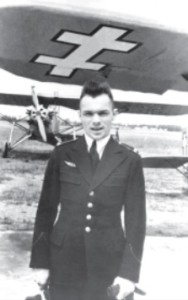
When France was occupied by Germany, he was transferred to French North Africa. This post, apparently not to his liking, prompted him and some likeminded associates to concoct a daring plan to commandeer several aircraft and fly to England. Because of increased security at the airfields, and despite diligent preparation, this plan did not work out. He pursued other means alone. He is said to have escaped North Africa via a small boat to Malta–another of his exploits we know nothing about.
A more likely story is that he left Algiers by rail and, under constant risk of discovery by German surveillance, reached free Tangier by way of Morocco. From there, via Gibraltar, he went to England and joined the British Royal Air Force. Political red tape and tensions between France and Britain delayed this until August 1940, when he was finally demobilized by the French and could join the RAF before the end of that year. He had to falsify documents in order to qualify–he was three years older than the maximum age specified for new recruits.
While serving in the RAF as Pilot Officer and Flight Lieutenant, he took part in the now famous Battle of Britain where he piloted a Hurricane fighter plane with the Number 1 Squadron. Assigned to night fighter duty against enemy bombers and their fighter escorts, Marcinkus flew the most difficult and dangerous missions of his career. He is credited with downing at least one enemy aircraft. Most likely there were more, which were unconfirmed due to the nature of nighttime missions.
It was this action, in defense of coastal England against the Luftwaffe, which elicited Winston Churchill’s famous quote–“Never was so much owed by so many to so few”–in praise of pilots who fought alongside Marcinkus.
Two and a half years after the Battle of Britain was won, the fate of Romualdas Marcinkus was shrouded in mystery. As British combat losses were classified secret, official sources indicated only that he was lost on a combat mission over the English Channel and listed as missing in action. This was probably intentional misinformation. We know now that four RAF pilots were shot down when they took part in the epic attack on the German battleship Scharnhorst on February 12, 1942 as part of the action to stop the German Kriegsmarine Operation Cerberus. This was an attempt to sail a large squadron of ships including, Scharnhorst, Gneisenau and Prinz Eugen, supported by numerous small escort ships, to their home bases in Kiel and Wilhelmshaven. It is not known how Marcinkus survived this battle. Perhaps his parachuting skills came into play.
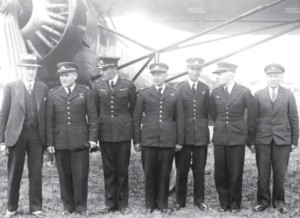
We next find him listed as a prisoner of war who was transferred to several different POW camps. The last one of these was Stalag Luft III, the camp reserved for those POWs–mostly officers– who had gained a reputation for repeated escape attempts from other camps. This camp will also be recognized as the one where the well-known “Great Escape” took place. The part Marcinkus played in the planning and execution of this remarkable endeavor should not be underestimated. Due to his command of several languages, including German, Polish, English, Lithuanian, and French, he became one of the leaders and organizers of the Great Escape.
In addition to his part in the escape plan, he also worked out options for evasion after the escape. His knowledge of German military dispositions and railway schedules was priceless to the planners. In the Oscar-winning Hollywood movie “The Great Escape,” Marcinkus is compared to Flight Lieutenant Hendley, the Scrounger, a composite character played by James Garner. Unlike that character, however, Romualdas Marcinkus did not survive the war.
Of the two hundred POWs cited for escape, only seventy-six managed to flee Stalag Luft III. And of those seventy-six, only three made good their escape. The rest were apprehended within twenty-four hours and handed over to the Gestapo. Within a few days, fifty were executed. Among them was Romualdas Marcinkus. Two days later his body was cremated in Danzig. The Gestapo claimed the recaptured POWs were not executed, but shot while trying to escape again.
When word of their fate reached the British Government, the executions were immediately declared war crimes of the highest magnitude, for which the criminals would be tracked down to the last man and brought to justice.
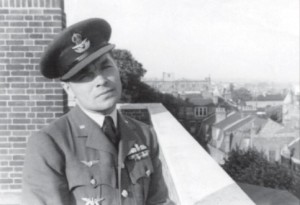
After the war, Allied investigation named seventy-two persons responsible for the executions. Marcinkus’ killer was convicted of murder in 1948. Later that same year, an urn containing the ashes of Romualdas Marcinkus was buried in the British section of the Old Garrison Cemetery in Poznan, Poland, his grave marked with an appropriately inscribed headstone.
British attempts to contact his relatives in Lithuania were thwarted by advice to stop trying because the country was under Soviet occupation, behind the Iron Curtain, and those relatives were sure to suffer negative consequences.
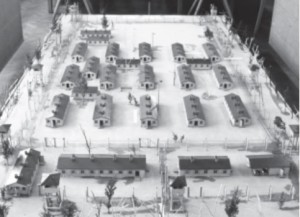
* * * * *
Let’s consider, for a moment, the military career of Romualdas Marcinkus: star athlete of international caliber, master parachutist and skydiving pioneer, handpicked pilot for trans-European demonstration flight, pilot in the air forces of three different countries, participant in two of the most famous air battles of World War Two, leader and organizer of the greatest POW escape of the war. It is hard to believe so much could be packed within the short, twenty year course of his career.
Currently, a street in Jurbarkas bears his name and an annual Lithuanian Air Force pistol marksmanship competition is conducted in his honor. In 2001, the RAF provided a fly-over by Harrier jets from Marcinkus’ Number 1 Squadron in a salute during commemorative ceremonies at the grave site.
Gražina Sviderskytė, the awardwinning journalist of CNN, wrote a book accounting the life of Romualdas Marcinkus titled Uragano kapitonas (“Hurricane Captain,”) published in 2004. A documentary film based on the book appeared the same year, and her book has been translated into English.
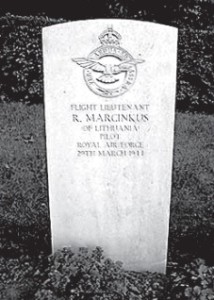
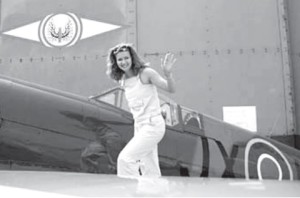
Sviderskytė next to a WW II vintage Hurricane fighter aircraft.
 DRAUGAS NEWS Lithuanian World Wide News in English
DRAUGAS NEWS Lithuanian World Wide News in English
